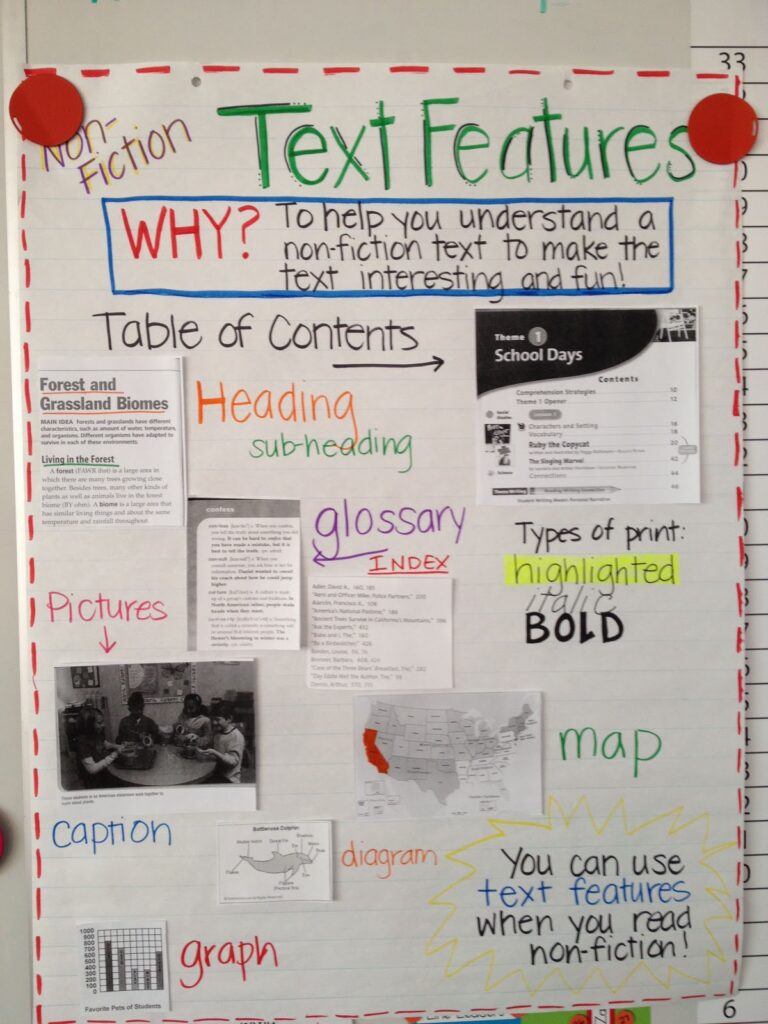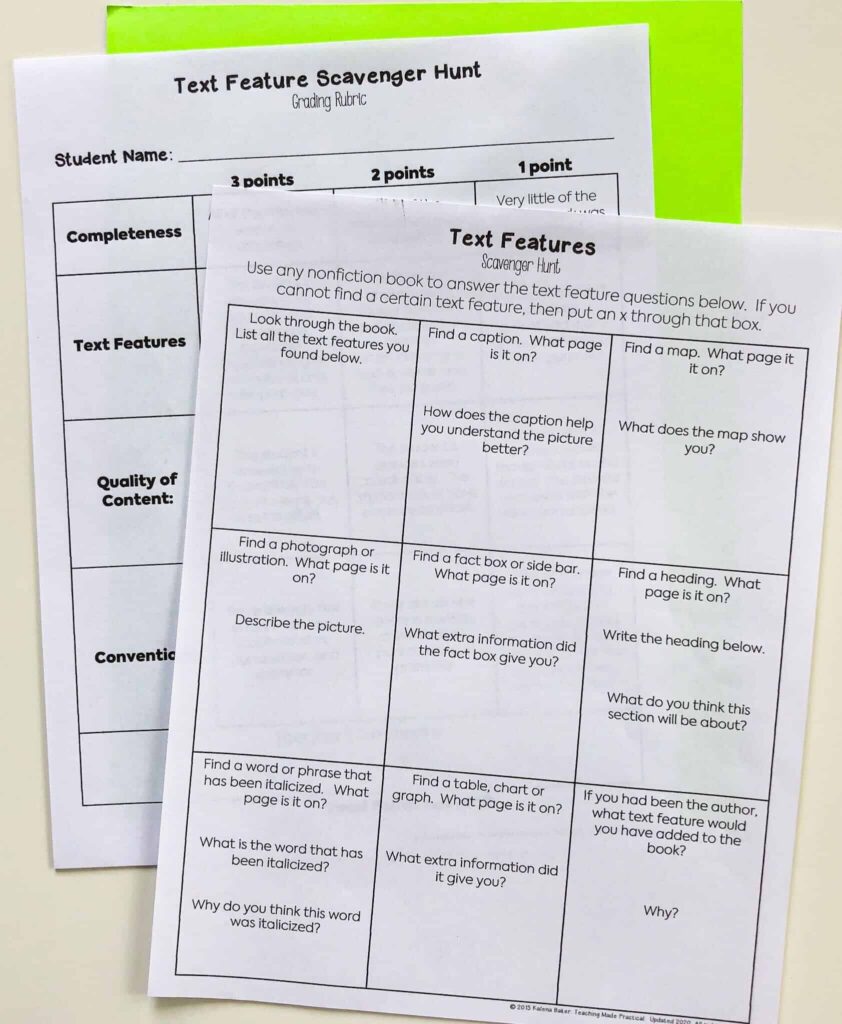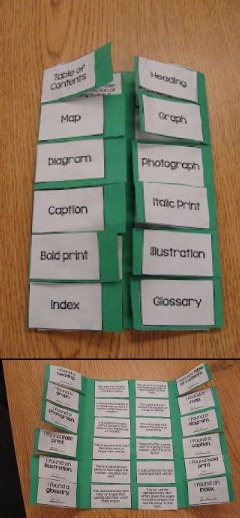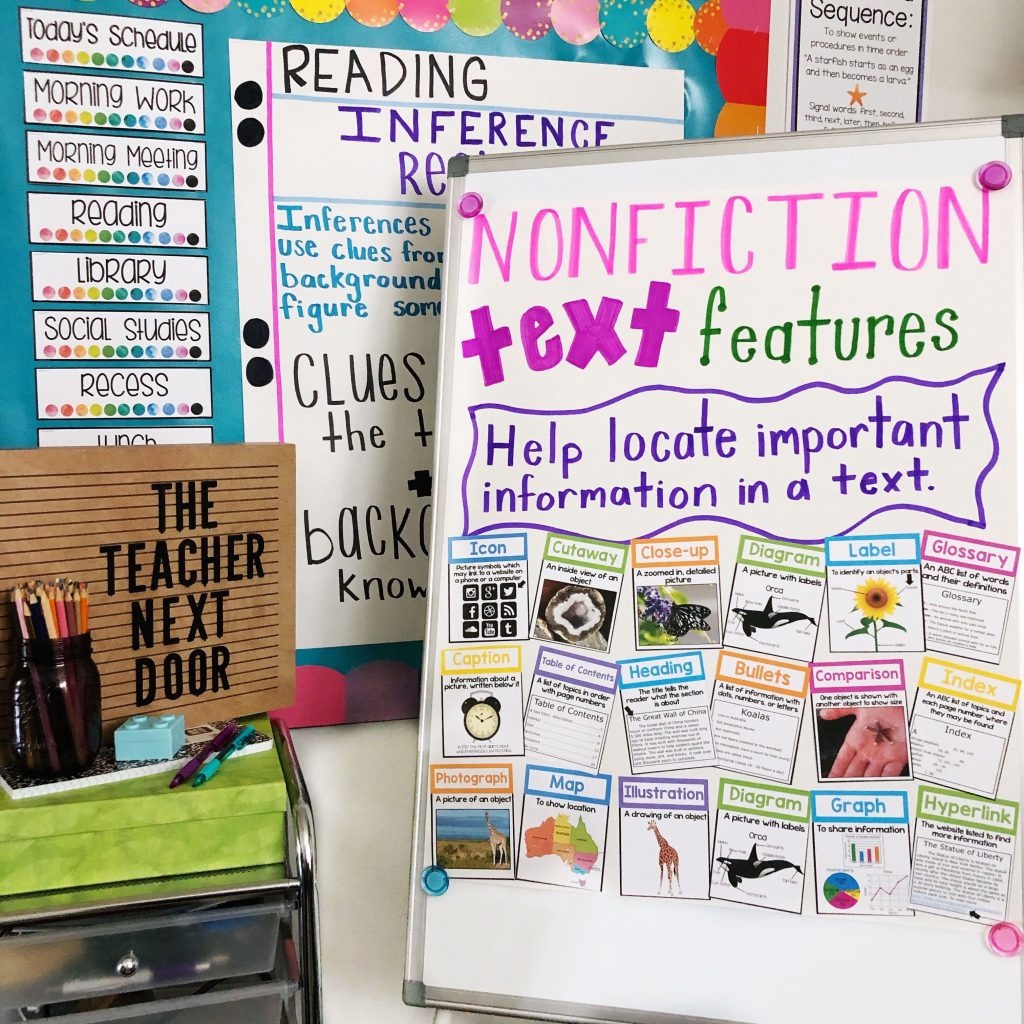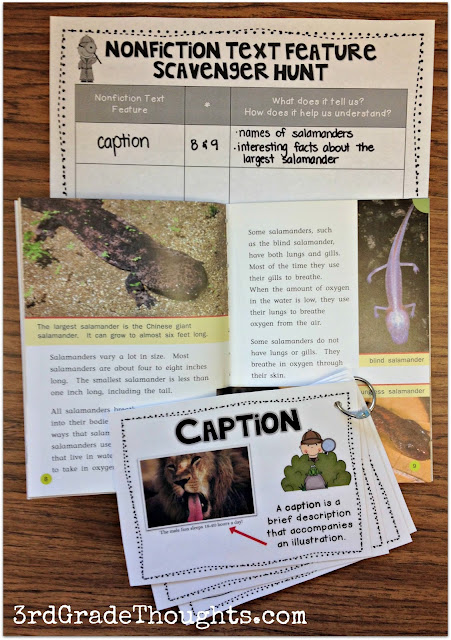A text is not just a text, it is an amalgamation of a number of features. This is what a text features anchor chart helps students to understand.
In this post, you’ll have the opportunity to look at examples of useful text feature anchor charts and to get some ideas for developing your own. I’ve also given you some tips about what to look out for in a chart and a few ideas on how to use them.
Table of Contents
- What to expect from a good text features anchor chart
- Different approaches to text features anchor charts
- Text features anchor charts from TeachSimple
- Ideas for Text Features Anchor Charts from other teachers
- Free resources
- Remember this…
What to expect from a good text features anchor chart
A good text features anchor chart must include all the elements that we can identify in a text.
For fiction texts, this includes: setting, characters, theme, inciting incident, problem, conflict, narrative position.
For non-fiction texts, this includes: captions, diagrams / illustrations, headings, subheadings, italics, bold text.
There must be a solid, understandable explanation of each feature. There should also be an example of each of these.
A good anchor chart dealing with features will be set out in a very structured way, because that is how texts, particularly non-fiction texts, work. This can mean using tables, boxes, or a grid structure.
Different approaches to text features anchor charts
There are, of course, as many ways of using an anchor chart to teach text features as there are teachers. There are also some commonalities that make the process easier.
A text features anchor chart can either be informational or interactive. Both are useful and both have their place.
- A chart containing only information is a great reference to have in class, especially when students analyze texts on their own.
- An interactive anchor chart gives great opportunities for students to find the relevant information and fill it in on the chart, thereby creating a classroom resource. The task can be done as an analysis of a text, or as a literal ‘taking apart’ of the text by cutting it up and adding it to the chart.
Text features anchor charts from TeachSimple
- Nonfiction Text Features Anchor Chart By First In Line



This is a rich resource for teaching the features of nonfiction texts. There are 12 anchor charts, some of which are complete. Others can be filled in by the students. They combine text and pictures, which means the students are presented with the point, an example and an explanation. This three-prong strategy gives the students all the information they need in one, well-organized go. Apart from the students using the chart to fill in their own, you can use them as the basis of an analysis of nonfiction texts.
- Comparing Two Texts Anchor Chart By First In Line


This resource is a set of four anchor charts that can be applied to any two texts. They give information about what to look for and hints to help the students go about making the comparisons. The charts include points that can be filled in by the students as they look at two texts. The blank charts can be displayed in relation to specific texts.
- Key Elements In A Text By Teacher’s Clipart



This resource is very straightforward and is a great reference for your classroom. The individual charts are very carefully presented. The visual examples make the information clear for the students. You can use this resource in just about any grade, although you may want to add to the examples in the higher grades.
Ideas for Text Features Anchor Charts from other teachers
- Features Of Nonfiction Texts From It’s Grow Time!
This is a chart that presents the features of nonfiction texts. This is a really great idea for setting out how to work out the features of a nonfiction text. The idea for the chart is to pull apart a text literally. The design and layout of the chart is truly interactive. You can give each student, or a group of students, a copy of a text to work with. They can literally cut it up and add it to their own chart. Even more effectively, give different texts to groups of students. They must create a chart for their text. The charts are all displayed and the students can compare them.
- Text Feature Hunt From Teaching Made Practical
This is such a great chart that is about a Text Feature Hunt. This is a truly interactive anchor chart. The aim is for students to be able to fill in the blocks by following the instructions in each one, using the text as the source. It is best suited to older grades, but can easily be adapted for lower grades, by changing the questions and instructions a bit. What is so effective is how the chart places the emphasis on the student interacting with the text.
- The Features Of A Text From Weebly
This anchor chart is a truly innovative way to present the features of a text. This has to be one of the most interesting and effective ways of using an anchor chart to guide the students through an analysis of the features of a text. The characteristics are clearly listed, while the inside elaborates on each one. What is also great is that you can use this approach for any grade. You’ll just need to adapt the elements you use and the demands of the inside points for the grade you teach.
- Resource On Non-Fiction Text Features From The Teacher Next Door
This chart makes a great resource on non-fiction text features. This anchor chart is definitely a useful reference resource for your classroom. The elements of a non-fiction text are clearly presented. They are color coordinated, which adds to the efficiency of the chart. Each point has a heading, explanation and example/s. The three elements give enough information for the students to be able to work on in relation to each feature.
- Scavenger Hunt From 3rd Grade Thoughts
This chart is based on a scavenger hunt to find the text features. This is specified as a grade 3 resource, but can be used with higher grades as well. The chart is completely interactive with cards that guide the students to look for features in a text. The general information about each feature is then entered on the chart. In this way, it’s the students themselves who will build up the resource on text features.
Free resources
- Features Of Fiction Texts By Broad Heath Primary School
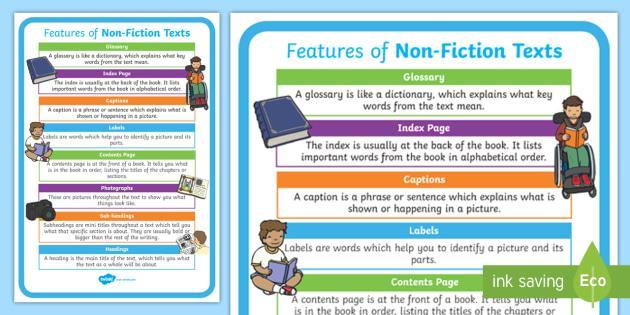
This anchor charts looks at the features of fiction texts. This anchor chart is quite a formal and relatively dense presentation of the features of fiction texts. It is a very good reference to work from and to display in the classroom. I suggest using it as the basis for discussions and analyses with students. Don’t just display it and expect the students to work through or with it. The amount of information may be a bit daunting for them to work with unfiltered.
Remember this…
The focus of a text features anchor chart should be on presenting the different elements AND on exemplifying them for the students. This will give them the information they need to analyze a text and break it up into features.

